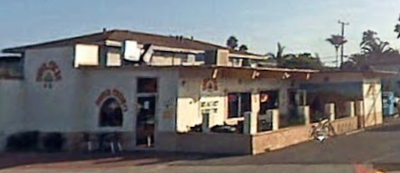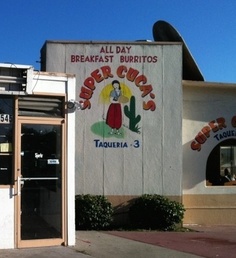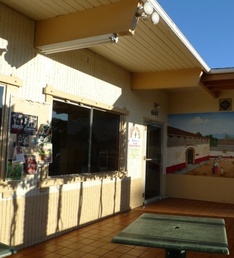Nebi's Coffee Shop was the first restaurant in Isla Vista, open from 1959 to about 1971. It was run by Nettie J. Karras and William (Bill) Karras; "Nebi" was a combination of their names. They ran it as a small family restaurant, during the dusty quiet days of IV, until the growing counterculture made this style of restaurant obsolete.
The building later became a series of Mexican restaurants, with modifications (such as an arched window and a patio) to make it fit the part better instead of looking like a 50s diner. It was Lupita's and then Super Cucas in its last years. It got torn down in 2011 so that the site could become part of the Icon. For more photos of this block before it became the Icon and the Loop, see the Loop.
 From page 250 of the 1960 UCSB yearbook. WO 79184 is an old-style phone number, with the WOodland telephone exchange name.
From page 250 of the 1960 UCSB yearbook. WO 79184 is an old-style phone number, with the WOodland telephone exchange name. Super Cucas in 2007 on Google Street View, from a similar angle. The addition at the back had customer restrooms.
Super Cucas in 2007 on Google Street View, from a similar angle. The addition at the back had customer restrooms.
Nebi's is described in "Profile of Downtown Isla Vista" by Michel Nellis (1990) as the second business in town after IV Market: "In 1959, the second retail business, Nebi's Coffee Shop, opened. William and Nettie Karras had moved to California from the Midwest where they had operated one of eighteen restaurants in a town of only five thousand people. While Karras was working in a Hollywood restaurant, a friend told him there was good money to be made in Lompoc. Karras and his wife hated Lompoc, but they fell in love with Santa Barbara. They also heard that Isla Vista would be a good place to open a restaurant since the college had located nearby. Their restaurant at 6547 Trigo was the first new commercial building in the community. Karras remembers that the restaurant business was fantastic since both students and Goleta-based company employees patronized it." (pages 5-6) Those Goleta employees were likely working at the military research and development companies growing rapidly in Goleta in the early 60s (they also influenced St. Michael's University Church).
"Bill Karras put Nebi's up for sale, first in 1969 and then again in 1973, because the "happy-go-lucky" young people were leaving. They were replaced by a more angry and unfriendly group of people and business dropped to "next to nothing."" (page 86)
Nettie's obituary says "They moved to California in 1957 and settled in Santa Barbara where they owned and operated NEBI's Coffee Shop in Isla Vista until they retired in 1971."
The UCSB and IV Walking Tour says "Site of Isla Vista’s first restaurant, Nebi’s Coffee Shop (6547 Trigo), now Super Cuca’s 3. On the north wall of the restaurant is an aerial photo of Isla Vista dating from about 1961, when Nebi’s opened for business." But the building is in the 1960 yearbook, so it probably opened in 1959 instead of 1961. That aerial photo is now in the new Super Cucas location on Madrid Road.
More photos
 From the 1962 UCSB yearbook (in the UCSB library).
From the 1962 UCSB yearbook (in the UCSB library). From July 2011, you can see where Nebi's striped wall used to be. By Britta Gustafson (CC BY-SA).
From July 2011, you can see where Nebi's striped wall used to be. By Britta Gustafson (CC BY-SA). October 2011, by Britta Gustafson (CC BY-SA).
October 2011, by Britta Gustafson (CC BY-SA).
Context
In the 2000s when this modest building was still at the end of the loop, with a dirt lot around it and a little shack storefront next to it, this little part of IV felt strangely rural. Learning that it was the first commercial building in IV makes that feeling make much more sense - there wasn't much around when it was built.
 1959 aerial imagery (UCSB map layer)
1959 aerial imagery (UCSB map layer) Recent aerial imagery (Google Maps)
Recent aerial imagery (Google Maps) Looking south at the Icon with 7-Eleven on the corner, April 2015, by Britta Gustafson (CC BY-SA)
Looking south at the Icon with 7-Eleven on the corner, April 2015, by Britta Gustafson (CC BY-SA)
There is not much in IV that has lasted to fifty years old without demolition, abandonment, or significant changes. Part of this is that some of it was built cheaply to begin with, part of it is land use changing toward more density, part of it is changing fashions, part of it is natural damage such as earthquakes and erosion. Part of it is SB County Redevelopment Agency and IV Master Plan investments to redevelop blight.
- The 1920s Campbell Ranch buildings are in bad shape - Devereux Hall (1924) is vacant and boarded up, and the beach house ("jailhouse") and earthquake-damaged barn are in ruins.
- The Cliff House at Coal Oil Point (mid-1940s) is mostly vacant, and UCSB plans to demolish it eventually.
- The Parking Lot House, possibly built in the 50s or earlier, got torn down in 2012, replaced by an apartment complex.
- The Rancho House, built sometime between 1947 and 1956, is still used as a house although not in good condition.
- The 1957 house at the end of Del Playa got torn down in 2013, replaced by a larger house.
- 955 Embarcadero Del Mar (1961) got a bad renovation in 2012.
Buildings around 1963 and later are doing a little better; see Articles By Decade.


